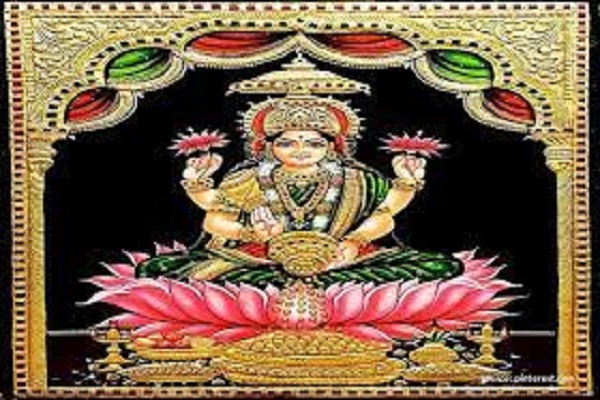
Lakshmi Tanjore Painting is a traditional art form from the town of Thanjavur (Tanjore), Tamil Nadu in southern India. It is characterized by rich, vibrant colors, intricate designs, and the use of precious stones, such as pearls and rubies, to highlight certain features.
Lakshmi Tanjore paintings are significant for their religious and cultural importance. They typically depict Hindu gods and goddesses, with Lakshmi, the goddess of wealth and prosperity, being a popular subject. These paintings are often used as decorations in homes, temples, and other sacred spaces, and are considered to bring good luck and blessings to those who display them.
The origins of Lakshmi Tanjore Painting can be traced back to the 16th century, during the reign of the Nayakas, a dynasty of rulers in southern India. The art form flourished under the patronage of the Maratha rulers of Thanjavur in the 17th and 18th centuries. Today, Lakshmi Tanjore Painting continues to be a cherished art form and is practiced by skilled artists and craftsmen in Thanjavur and other parts of India.
Famous Lakshmi Tanjore Paintings
Check out the details around famous Lakshmi Tanjore paintings!
Sri Lakshmi Narayani
The first famous Lakshmi Tanjore painting is titled "Sri Lakshmi Narayani" or "Goddess Lakshmi with Lord Vishnu". The painting measures approximately 18 x 14 inches and is made using traditional materials such as wood, cloth, and natural pigments.
The painting depicts the goddess Lakshmi seated on a lotus flower, with Lord Vishnu, her consort, beside her. Lakshmi is shown with four arms, holding a lotus, a conch shell, a pot of gold, and making a gesture of blessing. Lord Vishnu is shown with four arms as well, holding a conch shell, a discus, a mace, and a lotus. The painting is adorned with precious stones and gold foil, emphasizing the wealth and prosperity associated with the goddess.
The painting represents the divine union of Goddess Lakshmi and Lord Vishnu, who are worshipped as the ideal couple in Hindu mythology. Lakshmi is the goddess of wealth and prosperity, and Vishnu is the preserver of the universe. Together, they symbolize harmony, abundance, and divine grace. The painting is believed to bring blessings and good fortune to those who keep it in their homes or places of worship.
Ashta Lakshmi
The second famous Lakshmi Tanjore painting is titled "Ashta Lakshmi" or "Eight Forms of Lakshmi". The painting measures approximately 20 x 16 inches and is made using traditional materials such as wood, cloth, and natural pigments.
The painting depicts the eight forms of Lakshmi, each associated with a specific aspect of wealth and prosperity. The eight forms are Dhana Lakshmi (wealth), Vidya Lakshmi (knowledge), Dhanya Lakshmi (food), Santana Lakshmi (progeny), Vijaya Lakshmi (victory), Veera Lakshmi (courage), Gaja Lakshmi (elephants), and Adi Lakshmi (eternal prosperity). Each form is depicted with its own set of symbols and attributes, such as a pot of gold for Dhana Lakshmi and a book for Vidya Lakshmi.
The painting represents the different aspects of wealth and prosperity that Lakshmi embodies. Each form of Lakshmi is worshipped for a specific purpose, and together they represent the complete spectrum of abundance and well-being. The painting is often displayed in homes and businesses to attract prosperity and good fortune.
Goddess Saraswati
The third famous Lakshmi Tanjore painting is titled "Goddess Saraswati". The painting measures approximately 16 x 12 inches and is made using traditional materials such as wood, cloth, and natural pigments. The painting depicts the goddess Saraswati, the Hindu deity of knowledge, music, and the arts. She is shown with four arms, holding a book, a stringed instrument called a veena, and making a gesture of blessing. She is seated on a lotus flower, which represents purity and enlightenment. The painting is adorned with precious stones and gold foil, highlighting the importance of knowledge and creativity in human life. The painting represents the importance of knowledge, creativity, and the arts in Hindu culture. Saraswati is worshipped as the patron of learning, music, and poetry, and is believed to bestow blessings on those who seek knowledge and wisdom. The painting is often displayed in homes, schools, and other places of learning to invoke the blessings of the goddess and inspire a love for knowledge and the arts.
Conclusion
In conclusion, the three famous Lakshmi Tanjore paintings discussed - "Sri Lakshmi Narayani", "Ashta Lakshmi", and "Goddess Saraswati" - are not only beautiful works of art but also reflect the deep cultural and spiritual meanings of Hindu mythology. These paintings hold great significance in Indian art and continue to inspire people around the world.
If you are interested in buying Indian artwork, we recommend visiting IndianArtIdeas.in, which offers a wide range of traditional and contemporary Indian paintings from various regions and art styles. Their collection includes Tanjore paintings, Madhubani paintings, Warli paintings, and much more, all of which showcase the richness and diversity of Indian art.





















